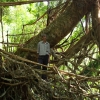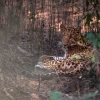Increasing urbanization, habitat destruction, pollution, biological invasions, increasing greenhouse gases and excessive use of natural resources are some of the anthropogenic factors that have damaged the environment. As a result, global temperatures have increased substantially and the impact can be seen in altered rainfall patterns, droughts, floods in coastal areas and extinction of several species. Sound environmental awareness is therefore necessary to handle such environmental issues and restore the degraded ecosystems. Today, with issues such as global warming, climate change, various pandemics including recent outbreaks of Ebola and Zika, nature education has become all the more important. The younger generation will soon be facing several environmental challenges and it must be prepared to tackle these effectively. Therefore, a commitment towards providing nature education is the need of the hour.
Nature education focuses on developing environmental consciousness and concern for the living environment. The objective of nature education is to develop awareness regarding the significance of biodiversity, which will then encourage people to take collective action towards biodiversity conservation. The Belgrade Charter (UNESCO-UNEP 1975) and Tbilisi Declaration (UNESCO 1978) furnish an internationally accepted foundation for environmental education. The Belgrade Charter was developed in 1975 at the International Workshop on Environmental Education held in Belgrade, Serbia, and provides a widely accepted goal statement for environmental education, which is to develop knowledge, skills, attitudes, motivations, and commitment to work individually and collectively toward solutions of current environmental problems and towards the prevention of new ones.
In June 1972, United Nations Conference on the Human Environment or the Stockholm Declaration propounded the concept of positive management of the environment for human benefit. It was the same year that a committee was set up in India under the initiative of the then Prime Minister Mrs. Indira Gandhi to coordinate environmental issues. The Constitution was amended by the 42nd Amendment Act in 1976 to incorporate environmental concerns in the document, vide Articles 48A and 51A. The Constitution of India explicitly makes environmental conservation a fundamental duty.
In order to restore the lost native biodiversity of Delhi, the Delhi Development Authority (DDA) has established the Delhi Biodiversity Foundation and has set up six Biodiversity Parks— Yamuna Biodiversity Park (YBP), Aravalli Biodiversity Park, Northern Ridge, Tilpath Valley, Neela Hauz and Yamuna river front. These biodiversity parks offer a variety of ecosystem services and have great conservation, recreational and educational value. Yamuna Biodiversity Park (YBP) located in Wazirabad, Delhi, is the first local government initiative in the world to develop a fully functional nature reserve on a once-barren urban landscape with the sustained efforts of scientific experts from Delhi University. It is a repository of more than 2000 species of plant and animals with 30 biotic communities. The park is an association of wetlands and forest communities situated on the western side of river Yamuna surrounded by dense human settlements. YBP is spread over an area of 457 acres. The park is divided into two phases. Phase I is located on 157 acres of an inactive floodplain. Phase II lies in active flood zone with an area of 300 acres. Both the phases are connected by a 200 m long functional corridor. The corridor allows animal mobilization in both phases during flooding and lean seasons.
Phase I has two sub zones; the visitors’ zone and the nature reserve zone. The visitors’ area has various modules of conservation including conservatories of fruit- yielding plants, butterflies and medicinal plants, sacred grove and rangelands assembled on ten mounds with different forest communities. The most biologically productive unit, the wetlands are also situated in the visitors’ area; a deep wetland, with an area of seven acres and a narrow-shallow wetland stretching over 1.8 kms.
A virtual nature trail in the visitors’ zone
The visitors’ zone of the park comprises of various modules for nature education with a closed trail of 3 km, meandering through various forest communities and wetlands. Sign boards have been put up with information about each area.
The nature trail starts at the entrance of the park. A few steps from the gate, along the trail, we can see various mounds with a variety of densely grown forest communities on the left hand side. The date palm (Phoenix dactylifera) growing here gives a glimpse of the relationship of plants with insects, spiders and many frequently visiting small birds such as the Ashy Prinia, purple sunbird etc.
Moving ahead, on the right hand side, one can see a beautiful stone structure that is embellished with plants such as Agave, Opuntia and some climbers. This stone facet depicts the origin and confluence of the rivers Yamuna and Ganga. The other side of the trail is adorned with bambusetum, having different species of bamboo.
Further along the trail, to the left is seen a huge beehive on a kala siris (Albizia lebbeck) tree. Here visitors can observe the ecosystem goods and services given by one of the most important insects on the planet, that is, the honey bee. Bees are among the most efficient pollinators on planet, and pollination, a precondition for reproduction, is one of the most important biological processes on this, the only planet known to have life.
A few steps further down the trail is a Nature Interpretation Center (NIC) which displays information about the park, its evolution and its features. The display boards at the NIC give a vivid pictorial representation of the history of ecological restoration at the park, and its vision. Information on the various flora and fauna associated with the Yamuna river basin is also displayed. Audio-visual touch screens showcasing information on biodiversity make the NIC a valuable space of learning for visitors.
Close to the NIC is the conservatory of fruit-yielding plants. Various plants that the Delhi-NCR region had in abundance but which came to be lost because of urban growth and reckless development are seen flourishing here. These include plants such as khirni (Manilkara hexandra), kaith/elephant apple (Limonia acidissima), cheeku/sapota (Manilkara zapota), and khajoor/date (Phoenix dactylifera). The fruit conservatory also acts as a reservoir of wild genetic resources and contains useful genes which could be used in the development of modern cultivars in term of growth rate, pulp and fibre content. There are various other fruiting trees and shrubs including falsa (Grewia asiatica), jamun (Syzygium cumini), goolar (Ficus racemosa) and ber (Ziziphus mauritiana).
Great bird diversity can be found in this area due to the availability of food and nesting space for birds. Here the trail bifurcates and leads to the two wetlands, the deep wetland on the right and the narrow-shallow wetland in the other direction.
The deep wetland which is a restored wetland spread over seven acres, has a depth ranging from 7 to15 feet. This wetland presents one of the most attractive sites in the park and gives an insight into how wetlands play an important role in maintaining vitality of a river. This ecologically functional wetland displays three layers of vegetation: submerged, floating and emergent. It acts as a suitable habitat for native as well as migratory birds. This wetland offers a live and vibrant experience of learning about the association and interdependence of terrestrial and aquatic ecosystems. Moving along the wetland, one can see the edge effect: at the edges of the wetland, biodiversity of both terrestrial and aquatic ecosystems are found, making it richer than each area taken individually (Leys 2011).
The other wetland dredged in the shape of a little river also supports many species of plant and bird, including the Black-crowned Night Heron that had stopped breeding in the Delhi NCR region 15 years ago. Such restored wetlands and associated ecosystems like the Tamarix-Phragmitis forest cannot be easily observed anywhere in the Delhi-NCR region. YBP thus offers its visitors an opportunity to look back into the past as it nurtures an assemblage of species from the Yamuna river basin which a couple of centuries ago bloomed naturally in the plains of Delhi. Here, one can have a first-hand experience of what Delhi might have looked like in the past, and learn why it is important to establish such biodiversity islands as YBP in the modern megacity.
A bamboo bridge has been constructed over the narrow-shallow wetland. The trail further leads to a butterfly conservatory established to attract the most important pollinators of nature. It features flowering and host plants important for butterflies to complete their life cycles, and also two small water-lily ponds which butterflies can use for mud-puddling, a process through which they acquire essential minerals. The butterfly conservatory thus offers visitors a glimpse into the life cycles of butterflies.
Throughout the trail, hoof marks and pug marks of various animals can be observed. These indicate the presence of the different species present in the park. The type of marks can be closely observed giving an initiation into species identification to students and enthusiasts. The track further leads to rangelands and a herbal garden conservatory, where one can see nearly 250 species of medicinal plants.
A living book and a living laboratory
YBP is a unique model of ecological restoration that provides an opportunity for alternative methods of learning about our environment. Various principles of ecological restoration read in books have been applied here practically. A unique field experience provided by Nature Education Officers (NEOs) and scientists benefits many students and wildlife enthusiasts. It has also become a life sciences research hotspot among research scholars. The park organizes various events on important days associated with environmental awareness, such as World Wetlands Day, Earth Day, World Environment Day and others.
Yamuna Biodiversity Park is thus a living laboratory where scientific experimentation has done wonders. Once a barren place where nothing grew, the park is now full of life which can be heard in the chirping of birds and rustling of leaves.
References
Leys, A.J. and J.K. Vanclay. 2011. 'Social learning: A knowledge and capacity building approach for adaptive co-management of contested landscapes'. Land Use Policy 28.3, pp. 574–84.
Ramakrishnan, P.S. 2001. 'Increasing population and declining biological resources in the context of global change and globalization'. Journal of Biosciences 26.4, pp. 465–79.
Ramachandra, T.V., B.H. Aithal. and U. Kumar. 2012. 'Conservation of wetlands to mitigate urban floods. Journal of Resources, Energy and Development 9.1, pp. 1–22.
Sarabhai, K.V., M. Raghunathan and S. Jain. 2002. 'Environmental Education: Some Experiences from India'. Institute for Global Environmental Strategies. Online resource (viewed on April 16, 2016).
Tews, J., U. Brose, V. Grimm, K. Tielbörger, M.C. Wichmann, M. Schwager, and F. Jeltsch. 2004. 'Animal species diversity driven by habitat heterogeneity/diversity: the importance of keystone structures'. Journal of Biogeography 31.1, pp. 79–92.










